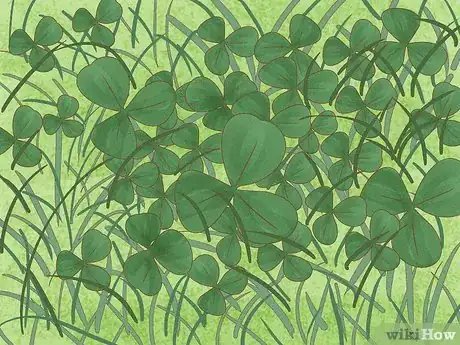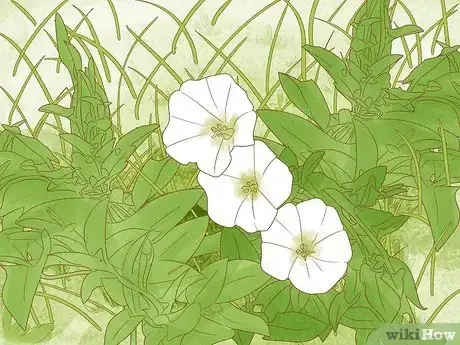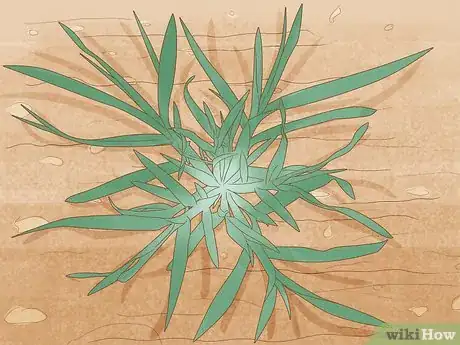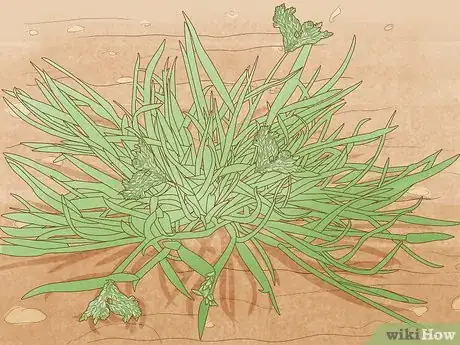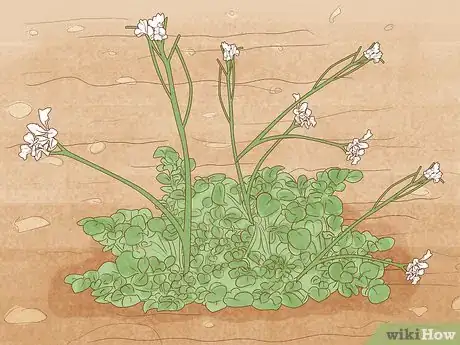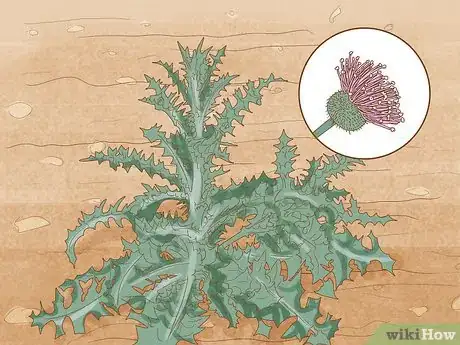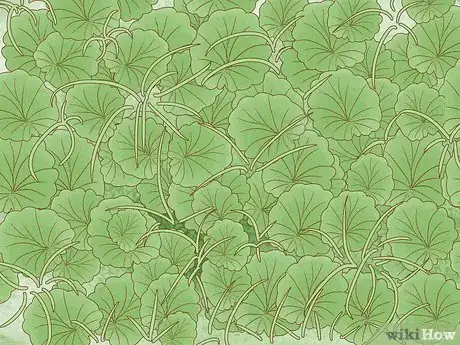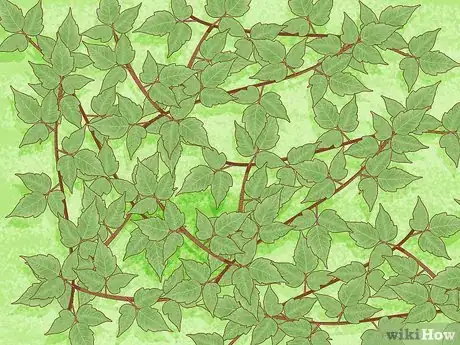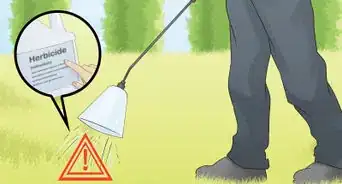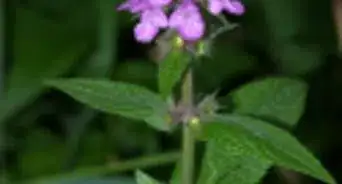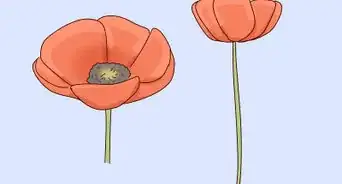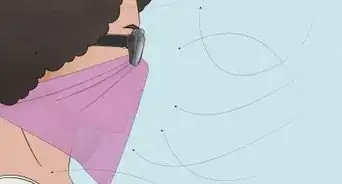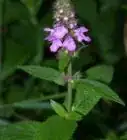This article was co-authored by Maggie Moran. Maggie Moran is a Professional Gardener in Pennsylvania.
There are 16 references cited in this article, which can be found at the bottom of the page.
This article has been viewed 113,567 times.
If you have a lawn or garden, then you know what a pain weeds are! They can ruin a nicely-manicured lawn and even overtake gardens by snatching up nutrients from the soil. The first step to fighting back is identifying the types of weeds you’re dealing with. There are literally hundreds of weeds in the world, so this can seem overwhelming. However, some types are much more prevalent than others. Here are some of the more common weed types that you might be dealing with. Once you've identified the weeds you have, you can then take some steps to get rid of them.
Steps
Flowering Weeds
-
1Dandelions: These are some of the most common weeds that grow on lawns. When blooming, dandelions have a distinctive yellow flower surrounded by a mass of leaves. The leaves are usually jagged and pointed at the end. When they aren’t blooming, dandelions have a tan or brown stalk leading to a bulb. This bulb looks like a round cotton ball when seeds are sprouting.[1]
- Dandelions can grow year-round but tend to flower in the spring and fall.
- Dandelion leaves and stalks leak a milky sap when they’re cut.
- Dandelions can grow almost anywhere, so you might see them all over the world.[2]
-
2Clovers: These weeds produce bunches of small, round flowers surrounded by oval or rounded leaves. The flowers are commonly white, but they could be red, purple, or slightly blue as well. They’re very common on lawns but can also grow between concrete and other less hospitable areas. Clovers are perennials that can grow at any time, but they go dormant in the winter and bloom again in the spring.
- These weeds also grow widely and can be spotted in most parts of Europe and North America.[3]
- While they might be an eyesore, clovers are actually good for a lawn because they release nitrogen into the soil. Keeping some around might help your grass grow better.
Advertisement -
3Deadnettle: Deadnettle grows upward with vertical leaves. These leaves go from green at the bottom to purple near the top, and there is usually a small pink flower at the top of the leaf column. They tend to grow in clusters close together, so it's not usual to see large bunches of them. If you've cut your lawn too short, deadnettle grows much better.
- Deadnettle is a winter and spring plant. It usually blooms in the early spring and then dries out by late spring.
- Deadnettle is native to Europe and Asia, but has spread to North America and grows widely in the United States as well.
- Other nettles look slightly different, but most still produce purple or pink flowers when they’re in bloom.[4]
-
4Wild violet: These weeds produce blue or purple flowers surrounded by broad, clover-like leaves. When not in bloom, the plant is just a mass of these leaves without flowers. They’re common on short lawns, but are also wildlife plants that grow in the normal environment.
- These are perennials, so they can grow at any time.
- Wild violet is most common in Canada and the northern US. It could also grow in Europe, but it's not as common.
- Wild violet usually doesn’t grow very tall, and should be less than 1 ft (0.30 m).
-
5Bindweed: This is a tough weed known for its rounded white flower. It also produces vines along the ground with long, pointy leaves. These weeds grow very fast in hot weather, and can spread more than 10 ft (3.0 m) wide. A bindweed outbreak can easily overtake a lawn, so you should take steps to get rid of them as soon as you see them.[5]
- Bindweed can also creep along the ground, so it’s easy to confuse with other creeping plants like ivy before it blooms.
- While technically a perennial, bindweed grows mostly in the spring and summer. It's native to the US, but has spread widely and now grows all over Europe and Asia.[6]
Grass-Like Weeds
-
1Crabgrass: This is one of the most common grass-like weeds around. Grassy leaves sprout from a central bulb and grow outward, like a crab's legs. This produces circular patches that are pretty easy to spot on well-manicured lawns. It grows year-round once it spreads on a lawn.[7]
- Crabgrass leaves often have clear or white hairs sprouting out. However, there are also smooth types with no hair.
- Crabgrass can be tough to spot if it breaks out on a lawn that isn’t well-maintained. The main thing to look for is clumps of grass that look different from the surrounding grass. Crabgrass is usually lighter or shaped differently than the other grass on your lawn.
- This weed is very widespread and can be found in virtually any area around the world.[8]
-
2Goosegrass: This weed looks very similar to crabgrass and the two are often mistaken. Like crabgrass, goosegrass leaves grow out from a single point. The main difference is that the stems on goosegrass are milky white, and then get greener as the leaves grow. It also germinates a bit later in the summer than crabgrass.
- Goosegrass is also widespread, though not quite as much as crabgrass. It's native to Europe and Asia, but grows heavily in the southern and western US.
- Goosegrass can grow pretty tall, and could top 2 ft (0.61 m) if left alone. When it’s tall, it sprouts feathery-looking seed heads from its tips.
-
3Bluegrass: This small winter weed is easy to spot on manicured lawns. It produces hairy, feathery seed sprouts from its leaves. From a distance, these sprouts can make the grass look like very tiny trees. This plant is native to the southern US, particularly Kentucky, but can grow throughout the rest of the country as well.
- Bluegrass is short, and is usually under 1 ft (0.30 m)
- Despite the name, bluegrass isn’t actually blue. Its color might not be much different from the surrounding grass, so don’t rely on color to spot it.
-
4Wild garlic: From a distance, wild garlic just looks like taller grass. However, it’s a completely different plant, and garlic bulbs are producing the grass. These are easy to spot. Look for bunches of tall, thin grass sprouting straight up in patches. The sprouts are usually much darker and taller than the surrounding grass.
- Wild garlic is native to Britain and northern Europe, but has spread worldwide.
- These are perennials, but they usually pop up in the spring and summer.
Leafy Weeds
-
1Ragweed: This is a common allergy trigger, so you’ve probably heard of it without ever seeing it. Ragweed grows from a single bulb and produces bright green leaves that form triangles, similar to the way a fern looks. As the plant grows, feather-like growths sprout from the tops and produce seeds. This usually happens in the warm weather, which is why your allergies might be worse in the spring and summer.
- Ragweed isn’t as common on lawns and grows more often in fields, meadows, and ditches.
- This weed is most common along the eastern seaboard of the US, but it also extends upward into Canada and some parts of the Midwest.
- Ragweed can grow very tall, and could even reach 4 ft (1.2 m) if left alone.
-
2Bittercress: This weed looks like a clump of dark green leaves with brownish stems protruding upwards. The leaves make a semi-circular or clover shape and tend to grow along a small vine. In the summer, white or purple flowers bloom from the stems. On some types, the stem is hairy or spiny.[9]
- When it’s first blooming, bittercress looks like a group of semi-circular leaves of varying size.[10]
- Bittercress is more common in wooded areas than on lawns or in gardens. It grows often in the US and Canada, but could also appear in Europe.
-
3Thistle: This is a creepy-looking plant with spines and points, almost like a cactus. It grows up in a green stalk and produces leaves with thorns on them. It then sprouts green, purple, or pink bulbs from the top of its stem during the growing season.[11]
- When it’s first growing, thistle produces a mass of smaller, pointy leaves from a central bulb. The stalk then grows up from this bulb.
- Different types of thistle grow widely in the eastern and Midwestern US, as well as in Canada.
- There are some differences between Canada and Texas thistle, but both have distinctive pointy leaves and purple bulbs.[12]
- As you might’ve guessed, thistle is painful if you grab it. Wear thick gloves if you’re trying to pull it out.
-
4Groundsel: This weed also has pointy leaves, but they aren’t sharp like thistle. They grow in a mass of raggedy-looking leaves and produce stems that reach upward. In the spring, the stems grow dandelion-like yellow bulbs that produce seeds.[13]
- Groundsel is primarily a winter and spring plant. It grows widely in parts of the US and Europe, especially in the early spring.
-
5Japanese knotweed: This plant is native to East Asia, but was introduced to the US and is now considered an invasive species. It grows in thick shrubs with light green leaves. The leaves are long and fat, like half of an oval with a pointed tip. In late summer, the shrubs grow white flowers from long vines.[14]
- This is a perennial, so it will last a long time once it grows.
- Knotweed grows very large, and could even reach 9 ft (2.7 m) tall.
- Since knotweed is an invasive species, some areas have laws against planting it.
Creeping Weeds
-
1Ground ivy: Also called creeping Charlie, this plant grows along the ground with star-shaped leaves. The leaves are usually scalloped or have ridged edges. These plants also produce pink or purple flower buds in the summer.
- This weed is native to the UK but has spread throughout Europe and the US. In many places, it's considered an invasive species.
- Ground ivy also produces a pungent odor when crushed, so this is another telltale sign.
- This plant isn’t the same as poison ivy, so you don’t have to worry about touching it.
-
2Poison ivy: This is also technically a weed that can overtake lawns or gardens. It creeps along the ground and produces leaves in groups of 3. These leaves have smooth edges, and the vines sometimes climb up trees or walls.[15]
- The color of poison ivy varies depending on the season. In the spring and summer, it’s bright green, and it turns red in the fall.
- Poison ivy can technically grow in many parts of the world, but it's much more common in the US. Particular areas are the Northeast and Midwest.
- Poison ivy will cause a rash and irritation, so avoid touching it.
-
3Virginia creeper: Like ivy, Virginia creepers trail along the ground and could climb up trees. They produce distinctive, toothed leaves in groups of 5. The leaves are red when they first bloom, but gradually turn light green as the plant matures.[16]
- As the name implies, Virginia creeper grows widely in the southern US. It can also stretch further north but doesn't grow as well in cooler areas.
- While some people confuse creepers with poison ivy, the major difference is that creeper always has bunches of 5 leaves and poison ivy has bunches of 3.
- Virginia creeper berries are toxic if eaten and the plant sap could cause a rash. It’s best to avoid touching these plants.
-
4Bermudagrass: This can look like normal grass, but the main difference is that the leaves sprout from a vine that grows along the ground. The leaves are thin and sharp, like pointy blades of grass. The vine is brown or tan while the leaves are light green.[17]
- This is a perennial, but it tends to grow more when it’s warm out.
- Bermuda grass grows best in hot climates and is widespread in the southern US, South America, Africa, India, and Australia.
- While bermudagrass is a weed, some landscapers like to use it as turf because if its low height and resilience.
Community Q&A
-
QuestionAre weeds bad for my lawn or garden?
 Community AnswerWeeds are "bad" in your garden from the perspective they are competing for the resources of water and nutrients with your desired plants. Weeds can be beneficial in the garden in the non-growing season, as an indicator of what your soil may be lacking. Articles about "how to read your weeds" are informative for evaluating what your garden soil needs to be healthy so you can have more robust plants and a better harvest.
Community AnswerWeeds are "bad" in your garden from the perspective they are competing for the resources of water and nutrients with your desired plants. Weeds can be beneficial in the garden in the non-growing season, as an indicator of what your soil may be lacking. Articles about "how to read your weeds" are informative for evaluating what your garden soil needs to be healthy so you can have more robust plants and a better harvest. -
QuestionWhat is the best way to kill thistles?
 Community AnswerI cut away at the plant until I can grab it from the bottom and pull up its roots. Wear gloves to prevent being poked by thorns.
Community AnswerI cut away at the plant until I can grab it from the bottom and pull up its roots. Wear gloves to prevent being poked by thorns. -
QuestionWhat kind of weeds have thorns?
 Community AnswerThe black locust is a tree, not technically a weed, but it can be annoying. It's native to Appalachia, but is pretty common here in upstate New York. Seedlings have spikes on their stalks.Members of the blackberry family (related to roses) have thorns on their canes (long, flexible stalks), as do several varieties of thistle (in the Compositae family). The Compositae family also includes punctureweed, and others that have nasty spikes growing out of their "flowerhead." This is not an exhaustive list, by any means.
Community AnswerThe black locust is a tree, not technically a weed, but it can be annoying. It's native to Appalachia, but is pretty common here in upstate New York. Seedlings have spikes on their stalks.Members of the blackberry family (related to roses) have thorns on their canes (long, flexible stalks), as do several varieties of thistle (in the Compositae family). The Compositae family also includes punctureweed, and others that have nasty spikes growing out of their "flowerhead." This is not an exhaustive list, by any means.
References
- ↑ https://weedid.cals.vt.edu/profile/404
- ↑ http://www.columbia.edu/itc/cerc/danoff-burg/invasion_bio/inv_spp_summ/Taraxum_officinale.htm
- ↑ https://www.fs.fed.us/database/feis/plants/forb/trirep/all.html
- ↑ https://www.rhs.org.uk/advice/profile?PID=714
- ↑ https://www.almanac.com/content/common-garden-weeds
- ↑ https://www.oardc.ohio-state.edu/weedguide/single_weed.php?id=8
- ↑ https://aggieturf.tamu.edu/turfgrass-weeds/large-crabgrass/
- ↑ https://ag.umass.edu/turf/fact-sheets/biology-management-of-crabgrass
- ↑ https://weedid.missouri.edu/weedinfo.cfm?weed_id=48
- ↑ https://www.portlandoregon.gov/bes/article/471991
- ↑ https://www.portlandoregon.gov/bes/article/471991
- ↑ https://aggieturf.tamu.edu/turfgrass-weeds/texas-thistle/
- ↑ https://aggieturf.tamu.edu/turfgrass-weeds/common-groundsel/
- ↑ https://www.mda.state.mn.us/plants/pestmanagement/weedcontrol/noxiouslist/knotweed
- ↑ https://www.cdc.gov/niosh/topics/plants/identification.html
- ↑ https://plants.usda.gov/plantguide/pdf/pg_paqu2.pdf
- ↑ https://aggieturf.tamu.edu/turfgrass-weeds/bermudagrass/
About This Article
To identify weeds, look for any plant growing where it shouldn't be, like a garden, flower bed, or cropland. Weeds can vary a lot in their appearance and can have leaves, flowers, or seeds. You can find grassy weeds, leafy weeds, and woody weeds, depending on the area. If you encounter a plant that shouldn't be there, it's probably a weed. However, if you're unsure, look up common weeds and compare the images with your own plants. For more tips from our Gardening co-author, including descriptions of common weeds, read on!

